
Fernand Léger
Joseph Fernand Henri Léger (French pronunciation: [fɛʁnɑ̃ leʒe]; February 4, 1881 – August 17, 1955) was a French painter, sculptor, and filmmaker. In his early works he created a personal form of cubism (known as "tubism") which he gradually modified into a more figurative, populist style. His boldly simplified treatment of modern subject matter has caused him to be regarded as a forerunner of pop art.
Fernand Léger
August 17, 1955 (aged 74)
Legacy[edit]
Léger wrote in 1945 that "the object in modern painting must become the main character and overthrow the subject. If, in turn, the human form becomes an object, it can considerably liberate possibilities for the modern artist." He elaborated on this idea in his 1949 essay, "How I Conceive the Human Figure", where he wrote that "abstract art came as a complete revelation, and then we were able to consider the human figure as a plastic value, not as a sentimental value. That is why the human figure has remained willfully inexpressive throughout the evolution of my work".[22] As the first painter to take as his idiom the imagery of the machine age, and to make the objects of consumer society the subjects of his paintings, Léger has been called a progenitor of Pop Art.[23]
He was active as a teacher for many years, first at the Académie Vassilieff in Paris, then in 1931 at the Sorbonne, and then developing his own Académie Fernand Léger, which was in Paris, then at the Yale School of Art and Architecture (1938–1939), Mills College Art Gallery in Oakland, California during 1940–1945, before he returned to France.[24] Among his many international pupils were Nadir Afonso, Paul Georges, Charlotte Gilbertson, Hananiah Harari, Asger Jorn, Michael Loew, Beverly Pepper, Victor Reinganum, Marcel Mouly, René Margotton, Saloua Raouda Choucair and Charlotte Wankel, Peter Agostini, Lou Albert-Lasard, Tarsila do Amaral, Arie Aroch, Alma del Banco, Christian Berg, Louise Bourgeois, Marcelle Cahn, Norman Carton, Otto Gustaf Carlsund, Saloua Raouda Choucair, Robert Colescott, Lars Englund, Tsuguharu Foujita, Sam Francis, Serge Gainsbourg, Hans Hartung, Florence Henri, William Klein, Maryan, George Lovett Kingsland Morris, Marlow Moss, Aurélie Nemours, Gerhard Neumann, Jules Olitski, Erik Olson, Richard Stankiewicz, Theo Stavropoulos and Stasys Usinskas.[24]
In 1952, a pair of Léger murals was installed in the General Assembly Hall of the United Nations headquarters in New York City.[25]
In 1960, the Fernand Léger Museum was opened in Biot, Alpes-Maritimes, France.
Léger bequeathed his residence (at 108 Avenue du General Leclerc, Gif sur Yvette, Paris) to the French Communist Party, which later hosted negotiations of the Paris Peace Accords between the United States, Democratic Republic of Vietnam, Republic of Vietnam and the Republic of South Vietnam[26]
In May 2008, his painting Étude pour la femme en bleu (1912–13) sold for $39,241,000 (hammer price with buyer's premium) United States dollars.[27]
In August 2008, one of Léger's paintings owned by Wellesley College's Davis Museum and Cultural Center, Mother and Child, was reported missing. It is believed to have disappeared some time between April 9, 2007 and November 19, 2007. A $100,000 reward is being offered for information that leads to the safe return of the painting.[28]
Léger's work was featured in the exhibition "Léger: Modern Art and the Metropolis" from October 14, 2013, through January 5, 2014, at the Philadelphia Museum of Art.[29]
In 2022, it was announced that a lost painting of the rooftop series was discovered on the opposite side of the painting Bastille Day.[30]














